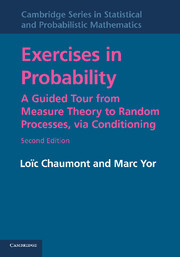Book contents
- Frontmatter
- Contents
- Preface to the second edition
- Preface to the first edition
- Some frequently used notations
- 1 Measure theory and probability
- Solutions for Chapter 1
- 2 Independence and conditioning
- Solutions for Chapter 2
- 3 Gaussian variables
- Solutions for Chapter 3
- 4 Distributional computations
- Solutions for Chapter 4
- 5 Convergence of random variables
- Solutions for Chapter 5
- 6 Random processes
- Solutions for Chapter 6
- Where is the notion N discussed?
- Final suggestions: how to go further?
- References
- Index
Solutions for Chapter 6
Published online by Cambridge University Press: 05 August 2012
- Frontmatter
- Contents
- Preface to the second edition
- Preface to the first edition
- Some frequently used notations
- 1 Measure theory and probability
- Solutions for Chapter 1
- 2 Independence and conditioning
- Solutions for Chapter 2
- 3 Gaussian variables
- Solutions for Chapter 3
- 4 Distributional computations
- Solutions for Chapter 4
- 5 Convergence of random variables
- Solutions for Chapter 5
- 6 Random processes
- Solutions for Chapter 6
- Where is the notion N discussed?
- Final suggestions: how to go further?
- References
- Index
Summary
In the solutions developed below, (ℱt) will often denote the “obvious” filtration involved in the question, and F = F(Xu,u ≤ t) a functional on the canonical path space C(IR+, IRd), which is measurable with respect to the past up to time t.
Solution to Exercise 6.1
1. (a) By assumption, (Rt, t ≥ 0) is a positive process, so it follows from Fubini theorem that
Then we derive from the assumptions (i) and (ii) that E[Rt] = E [R1] < ∞, so that if, then and hence, a.s.
(b) Applying Fubini theorem, we obtain that for any measurable set B,
Then the inequality follows from the hint.
(c) By definition of the set BN, we have. Moreover, the assumption (i) implies that
Then we conclude thanks to the inequality of question 1(a).
(d) If, a.s., then limN→∞ P(BN) = 1. Let us exclude the trivial case where R1 = 0, a.s. So we can ch∞se N sufficiently large and ε > 0 sufficiently small to have, for all, from which we derive that
Then we deduce that μ(0,1] < ∞ from the inequality of question 1 (c).
2. (a) Let us compute, for s < t.
First we note that
The process β is clearly a continuous centered Gaussian process.
Moreover, as we have just proved, its covariance function is given by E(βtβs) = s Λ t, s, t ≥ 0, hence β is a standard Brownian motion
This identity may be expressed as
Then considering the above equation as a linear differential equation whose solution exists and is (Bu, u < t), we see that B can be written as
for some measurable functional Φ, hence.
- Type
- Chapter
- Information
- Exercises in ProbabilityA Guided Tour from Measure Theory to Random Processes, via Conditioning, pp. 229 - 267Publisher: Cambridge University PressPrint publication year: 2012

